Frank's travels around Britain 2009.
Nunney & Mells, Somerset.
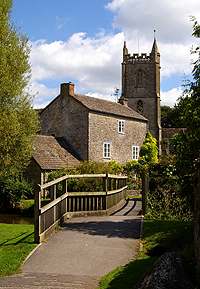
This trip became one of two halves. A crap Travelodge & two lovely villages on a glorious summers day in Somerset!
The trip was centred on the Travelodge in Devizes, Wiltshire. The room rate was a very good £19 but little did I know that it was a brand new Travelodge with their brand new, very obviously, pared down to the absolute bone, sleeping room. It is not an exaggeration to say that the room was just like you would imagine a modern prison room would be like! At least there was a double bed! There was no wardrobe area to unpack your clothes on to, just a bar sticking out of the wall with its attached hangers. I have never seen such thin pillows! Luckily the staff are lovely & will supply any amount of super thin pillows. Another thing, don't go rambling. If you want to relax in a warm bath ... it's gone. So has the plastic cup they used to supply in the bathroom. But the class act is the saving on a bedside table. I assume it's even beaten the Gideon Bible suppliers! The place you now put your cup/watch/glasses/mobile phone/book is now a cubby hole. About as deep & a little higher than the mug in the room. I reckon they think the floor is big enough to throw anything else on! The connection with the Little Chef is now broken completely & the food outlet that is incorporated is a Subway sandwich bar. In this particular area, there is a Morrison's cafe close by & in the town you can find a Wetherspoon pub, so not all is lost & a good inexpensive breakfast is close by.
At the prices Travelodge ask, I expected there always to be a lack of luxury but I think they have taken the concept of economy, a step too far.
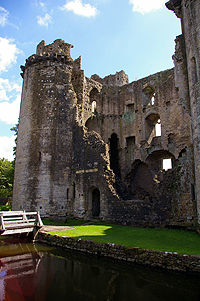 By the Tuesday all was forgotten (until I returned!). The sun was out, the
day was glorious & I found the Somerset village of Nunney. What a stunning,
hidden gem this place is.
By the Tuesday all was forgotten (until I returned!). The sun was out, the
day was glorious & I found the Somerset village of Nunney. What a stunning,
hidden gem this place is.
It looks like a film set. A castle with a moat, a beautiful bubbling river, one pub, one shop & in defiance of modern life ... no obvious car park. It has a sense of knowing it's perfect, letting you look & expecting you to move on soon. I suspect this is still a real village & not an abandoned tourist trap. The houses will be out of the reach of the average person & maybe it has its fair share of holiday lets but to an outsider, its stunningly beautiful, not over crowded or commercialised.
Nunney is mentioned as a manor belonging to William de Moyon in the Domesday Book in 1086, but the book does not mention a castle. Nunney Castle is a small, French-style castle surrounded by a deep moat, built for Sir John Delamare in 1373, and said to have been based on the Bastille in Paris, and shows a strong awareness of contemporary French practice. It is so worth seeing. The rooms, floor levels & turret details are all so clear. It was later the property of William Paulet, 1st Marquis of Winchester, before passing to several more owners. During the English Civil Wars (1642-51) Colonel Richard Prater, who held the castle until 1645, lost it to Fairfax, the commander of Cromwell's forces in the battle that took place at Nunney. The castle was besieged for two days, but capitulated when Cromwell's men used cannon to blast a great hole in the north wall of the castle.
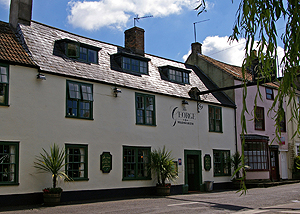 I
broke the golden rule of tight fisted OAPs & bought a lunch in The George. OK
it was probably inexpensive by southern standards but it was worth every penny.
The George at Nunney Inn, next to the church dates from the mid 18th century &
is a Grade II listed building. It's cliental did not seem to have any monetary
problems. They sounded like retired ex-pats & their ladies or the landed
gentry, far back accents & loud voices. My lunch of an enormous baguette stuffed
with local sausages, a lovely side salad & rough crisps. It was enough for
I
broke the golden rule of tight fisted OAPs & bought a lunch in The George. OK
it was probably inexpensive by southern standards but it was worth every penny.
The George at Nunney Inn, next to the church dates from the mid 18th century &
is a Grade II listed building. It's cliental did not seem to have any monetary
problems. They sounded like retired ex-pats & their ladies or the landed
gentry, far back accents & loud voices. My lunch of an enormous baguette stuffed
with local sausages, a lovely side salad & rough crisps. It was enough for
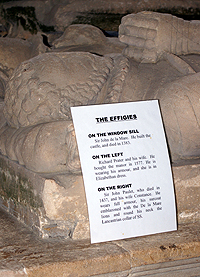 the whole
day. (In fact, my tea ended up as a vastly inferior sandwich & a little fruit
sneaked into the Travelodge). If I could afford it, it's the sort of Inn I'd
love to centre any Somerset trip.
the whole
day. (In fact, my tea ended up as a vastly inferior sandwich & a little fruit
sneaked into the Travelodge). If I could afford it, it's the sort of Inn I'd
love to centre any Somerset trip.
It is not known exactly when the church of The Church of All Saints (a Grade I listed building) was built, but some Saxon fragments survive which indicate the existence of the church in those turbulent days, and a heavy Norman font represents a later period of history. In the thirteenth century a de Montfort re-built it, and that famous Arthur Mee's Children’s Encyclopedia tells us that the proud possession of the church is a stone effigy of Sir John Delamere. He lies on a windowsill in the north aisle, above four other tombs which seem to have been casually disposed near him. Two are of Sir John Paulet and his wife Constance, he wearing a tabard and a Lancastrian collar, his lady a long veil. The two other figures, in Elizabethan costume, no doubt represent the successors to the Paulets – Richard Prater and his wife. High above eyelevel is the remains of a Medieval Wall Painting. It is meant to be St. George I believe.
The name of the village comes from Old English and probably means Nunna's island. Evidence of Roman settlement has been provided by the discovery of a hoard of roman coins in 1869 at Westdown Farm and a villa with a mosaic floor. There is an excellent history on the Nunney village webpage & is very detailed.
Today, it is the tourist attractions of the castle, with an historic church, a grade II listed pub and ducks wandering the streets near the river. An utterly delightful place. Sit by the river & listen to the sounds of an English village in warm summer sun ... no wonder a visit will be longer than you think.
The next village was strange in its own way. Mells. Unbeknown to me, this was the village at the centre of the rhyme of Little Jack Horner. And a wander around shows you how the village has Horner's name running through it's veins.
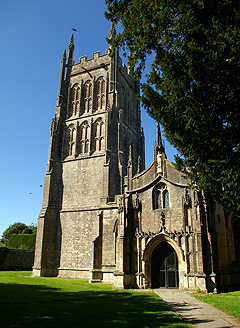 Little Jack Horner was reputed to have been the Steward to Richard Whiting
(1461 - 1539) the Bishop of Glastonbury. The Steward had an important role and
was responsible for managing the household, collecting taxes and keeping
accounts. It is rumoured that the Bishop tried to bribe the King Henry the VIII.
He sent his Steward, Richard Whiting, with a gift of twelve title deeds to
various English manorial estates. The deeds were said to have been secreted in a
pie (valuables were often hidden in this bizarre fashion to thwart thieves).
Whiting ( Little Jack Horner) realised that the bribe would do no good and was
said to have stolen the deeds to the manor of Mells (it being the real 'plum' of
the twelve manors).
Little Jack Horner was reputed to have been the Steward to Richard Whiting
(1461 - 1539) the Bishop of Glastonbury. The Steward had an important role and
was responsible for managing the household, collecting taxes and keeping
accounts. It is rumoured that the Bishop tried to bribe the King Henry the VIII.
He sent his Steward, Richard Whiting, with a gift of twelve title deeds to
various English manorial estates. The deeds were said to have been secreted in a
pie (valuables were often hidden in this bizarre fashion to thwart thieves).
Whiting ( Little Jack Horner) realised that the bribe would do no good and was
said to have stolen the deeds to the manor of Mells (it being the real 'plum' of
the twelve manors).
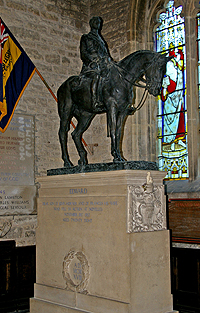 The remaining eleven manors were given to the crown but to
no avail. The old Bishop was convicted of treason for remaining loyal to Rome.
The jury included his treacherous steward Horner who found Bishop Whiting guilty
and sent the old man to a terrible death of being hung, drawn and quartered on
Glastonbury Tor. The Abbey was destroyed. Following the destruction of the abbey
the steward, Horner moved into the Manor of Mells. Whether Horner actually stole
the deeds to the Manor or was rewarded with them for helping to convict the
Bishop of Glastonbury is not known but the Manor of Mells became the property of
the Horner family who lived there until the 20th century. The first publication
date for the lyrics to the Little Jack Horner rhyme is 1725.
The remaining eleven manors were given to the crown but to
no avail. The old Bishop was convicted of treason for remaining loyal to Rome.
The jury included his treacherous steward Horner who found Bishop Whiting guilty
and sent the old man to a terrible death of being hung, drawn and quartered on
Glastonbury Tor. The Abbey was destroyed. Following the destruction of the abbey
the steward, Horner moved into the Manor of Mells. Whether Horner actually stole
the deeds to the Manor or was rewarded with them for helping to convict the
Bishop of Glastonbury is not known but the Manor of Mells became the property of
the Horner family who lived there until the 20th century. The first publication
date for the lyrics to the Little Jack Horner rhyme is 1725.
The name of Horner is everywhere. A shelter by the river was built by a Horner. The church is full of them but none more noticeable as Edward Horner. The centre of the chapel is dominated by an equestrian statue to Edward who fell at the Battle of Cambrai in 1917. It looks very strange to see this inside the church, fully mounted on a horse after dying at only 28 years of age. Stranger still, is the fact his body lies in France.
Fame wealth, money & influence seem to be everywhere in the churchyard. The Asquith family, Siegfried Sassoon (English poet and author. He became known as a writer of satirical anti-war verse during World War I). Sir Henry Bonham Carter (an English Liberal politician and cricketer who married an Asquith. Some of the gravestones don't stop at name, dates & "R.I.P". or "Resting in God's arms", the obverse side has huge tracks of poetry or verse covering it. Inscriptions on the walls in the church are completely in Latin, showing, I presume, the classical education of the upper classes.
After all that interest & worth destinations I managed to muck up Wednesday completely. The weather Gods decided that dull grey coverage would flatten the photographs, my belt decided after umpteen years to collapse. The staff were helpful, the nearest M&S was in Salisbury (a really nice place I've been to before) so instead of a straight journey in to an excellent car park I knew, guess who got lost? Tom tom took me to a very small car park that was very full. I spent ages trolling around one way roads, trying get back onto the one I thought I knew, after a loooong time, I ended up at the original one & hung around waiting for a space. (Yes, I am getting mad by this time). Of course M&S was the other side of town and to top it off, they had everything ... except the belt I have travelled hours to find. (No, I'm not any happier either). The day drew to a close with slight rain showers. I drove back the long way hoping to see good views of Stonehenge but I've never seen it look so flat & ordinary. I thought I might try the Middle Wallop Army Air Museum, but it looked so disappointing & expensive, I finally gave up & went back to prison!

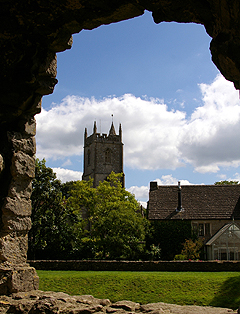
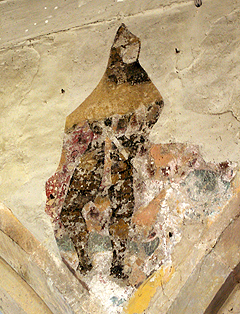
Links for information on this page:
